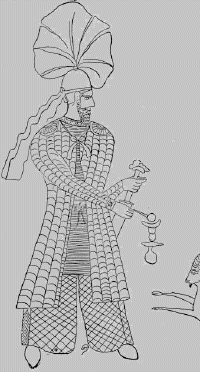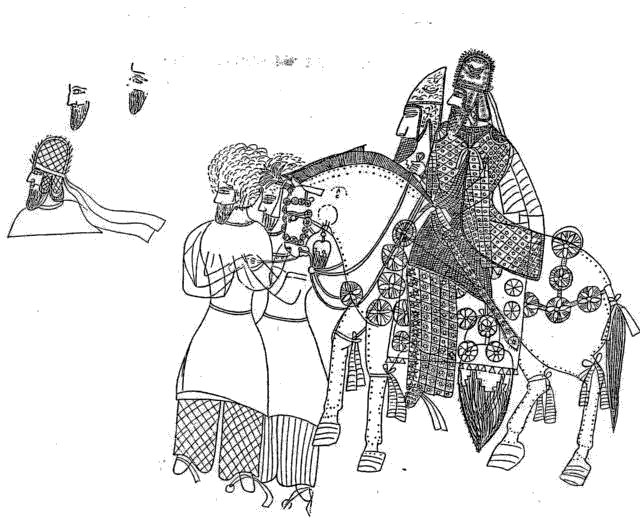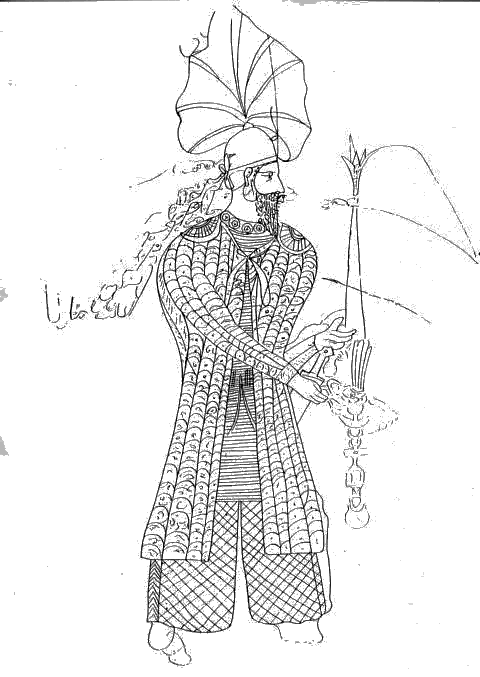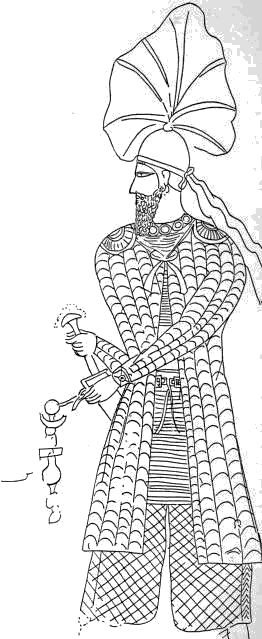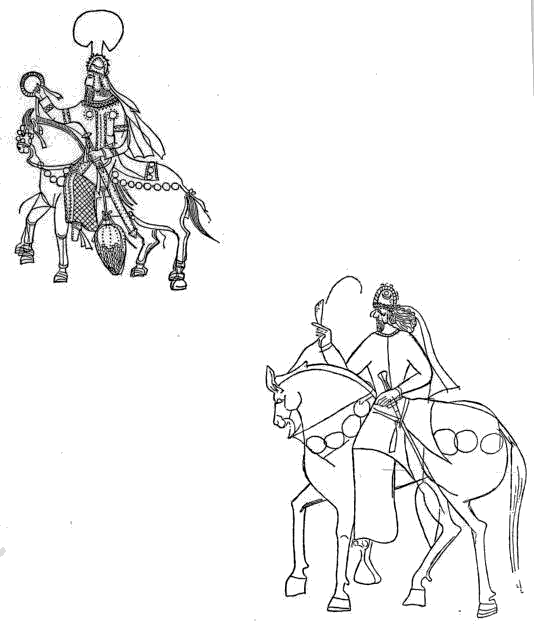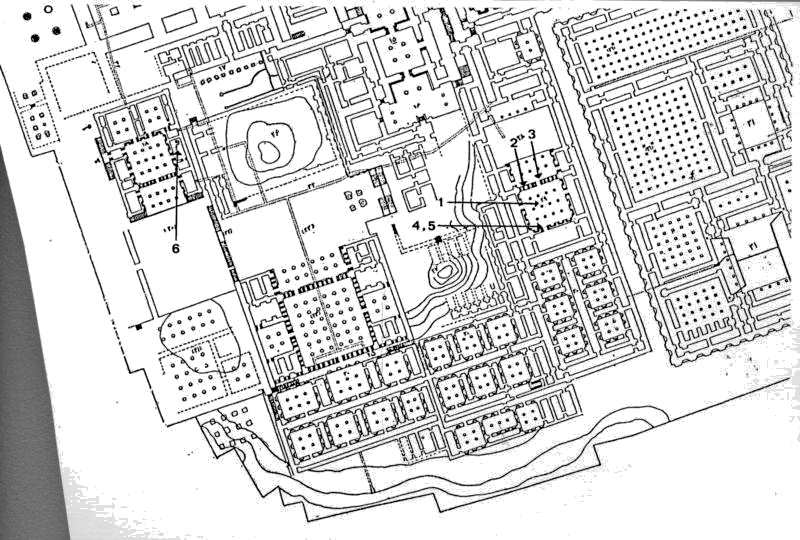The article below by Pierfrancesco Callieri, “At the Roots of the Sasanian Royal Imagery – The Persepolis Graffiti” was originally posted in the CAIS website.
=====================================================================
Introductory Summary
Among the most interesting evidence of post-Achaemenid age at Persepolis are a few graffiti, engraved with very thin lines on the limestone blocks of the Harem of Xerxes and of the Tacara.
While initially only isolated images of princely figures were recognised, a more accurate survey has shown that at least in two instances we have evidence of more complex scenes and perhaps of different “layers”.
By comparison with coins of the rulers of Persis, some of these figures have been identified as the immediate predecessors of the Sasanian kings.
In the light of the recent reassessment of the coinage of Fars and of the post-Achemenid epigraphical evidence, the author examines again the problem of the identification of the figures. Besides, the author proposes some reflections on the nature and function of these graffiti, investigating their link on one side with parallel production of graffiti, on the other with the few extant traces of Parthian and Sasanian painting.
This study is offered to Boris Marshak as a token of gratitude for his illuminating contributions to the understanding of the figural world of the Sasanians.
Main Article
Among the most interesting evidence of post-Achaemenid age at Persepolis are a few graffiti, engraved with very thin lines on the limestone blocks of the Harem of Xerxes and of the Tacara.
While initially only isolated images of princely figures were recognised, a more accurate survey has shown that at least in two instances we have evidence of more complex scenes and perhaps of different “layers”.
By comparison with coins of the rulers of Persis, some of these figures have been identified as the immediate predecessors of the Sasanian kings.
In the light of the recent reassessment of the coinage of Fars and of the post-Achemenid epigraphical evidence, the author examines again the problem of the identification of the figures. Besides, the author proposes some reflections on the nature and function of these graffiti, investigating their link on one side with parallel production of graffiti, on the other with the few extant traces of Parthian and Sasanian painting.
This study is offered to Boris Marshak as a token of gratitude for his illuminating contributions to the understanding of the figural world of the Sasanians.
Among the most interesting findings of the post-Achaemenid age at Persepolis are a few figural graffiti, engraved with very thin lines on the limestone blocks of the Harem of Xerxes, now the Persepolis Museum, and of the Tacara. They are only one aspect of the extremely abundant material engraved on the limestone blocks of the Achaemenid complex (see Curtis and Finkel 1999), prevailingly of epigraphical character and currently being investigated (S. Razmjou, personal communication).
While initially only isolated images of princely figures were recognised (Allotte de la Füye 1928; Herzfeld 1935, 1941; Schmidt 1953), a more accurate survey has shown that at least in two instances we have evidence of more complex scenes (Calmeyer 1976: 65-67; Abka’i Khavari 2000: 31, 37), which are extremely similar to some images on the rock-reliefs of the Sasanians. Despite the patent importance of this evidence for the study of the birth of the official art of the Sasanian dynasty, until now an overall view of the different figural graffiti has never been proposed (cf. Faccenna 1997: 89, fn. 30).
The main aim of the present contribution, which is offered to Boris Marshak as a humble token of gratitude for his illuminating contributions to the understanding of the figural world of the Sasanians, is the edition of a “catalogue raisonné” of the Persepolis figural graffiti, which must be considered preliminary due to a lack of adequate documentation which only new field-work will be able to produce.
At Persepolis, figural graffiti recorded to date are concentrated in two buildings: the Harem of Xerxes and the Tacara of Darius I.
As mentioned above, the available documentation on them is uncertain, not only because there has been some uncertainty in the description of the graffiti, but particularly because the graphic rendering of the same graffito in different publications is not always uniform, both in what concerns the isolated figures and the scene as a complex composition. In the absence of a new direct documentation, the only drawing which seems sufficiently reliable is that of Graffito no. 2 by B. Grunewald, published in Calmeyer 1976, which seems to be more accurate in the composition of the scenes and scale as compared to the drawings by Taghi Assafi published in Sami 1338 (see Calmeyer 1976: 65, fn. 132). Moreover, in some points near the principle scenes we find graffiti of isolated parts of figures, which may pertain to different chronological layers of graffiti, or instead, represent engraved patches which were then completed by painting (see below).
Here follows a brief description of the graffiti.
Graffito no. 1 (Sami 1338: fig. on p. 274) (Fig. 1) – A lion in full profile to left, sitting on his hind legs: a mane covers the entire upper part of the body up to the ears and neck, while a long thin tail with tuft of hair at the end is turned up parallel to the back. In the open jaws, its fangs are visible.
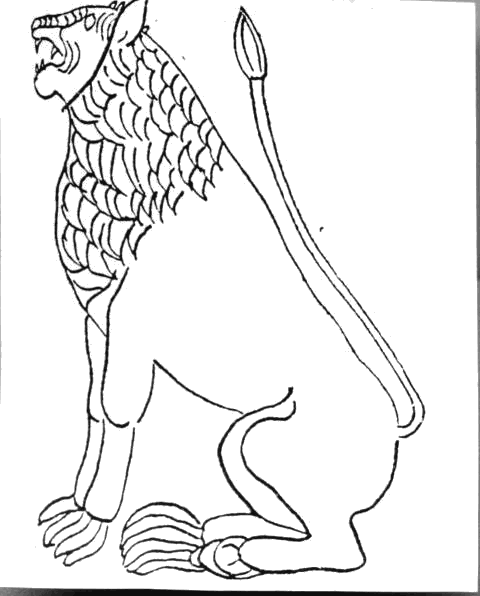 Fig. 1 – Graffito no. 1 (after Sami 1338: fig. On p. 274). Not to scale.
Fig. 1 – Graffito no. 1 (after Sami 1338: fig. On p. 274). Not to scale.
The heraldic pose of the animal is rendered with a certain plasticity of volumes. Given the uniqueness of this graffito, we will only mention here that the posture of the animal has an illustrious antecedent in the stone sculpture of a lion in the tomb of Antiochus I’s at Nemrud Dagh in Commagene (Ghirshman 1962: fig. 18), whereas the rendering of the head and tail is not dissimilar from that on some Sasanian silver vessels (e.g. Harper 1981: pl. 14). The attribution of the graffito, therefore, remains problematic.
Graffito no. 2 (Sami 1338: fig. after p. 274; Calmeyer 1976: fig. 3) (Fig. 2) – One scene composed by more figures, of which the two available illustrations give a different composition. In Calmeyer 1976, the long scene is basically centered on two princely mounted figures, one to the extreme left and the other to the extreme right, with isolated elements of other figures in between the two, whereas Sami’s version of the drawing gives a very different composition of the figures, and even the rendering of many details differs a lot.
 Fig. 2 – Graffito no. 2 (after Calmeyer 1976: fig. 3). Not to scale.
Fig. 2 – Graffito no. 2 (after Calmeyer 1976: fig. 3). Not to scale.
The main figure on the left part of the scene (Figs. 3, 4) is a male princely personage mounted on a horse, in profile to the left. The personage wears a tunic and trousers, each characterized by a different fabric rendered in detail, while the foot bears a plain shoe. Whereas the bust is frontally viewed, the head is in full profile to the left, with long rounded-tip beard; he wears a tall curved cap with ear-flaps and neck-shield, decorated with a crescent at the middle among embroidered (?) dots which form also a curved perimeter all around, and with what seems the indication of the scaled crest at the center of the tiara (cf. the heads from Hatra in Ghirshman 1962: figs. 100, 102), here seen in profile, with two long ribbons hanging down along the back. With the right hand extended before him he holds a ribboned ring-shaped diadem, while his left hand is placed on the hilt of the long sword, whose scabbard is decorated with pearls along the edges.
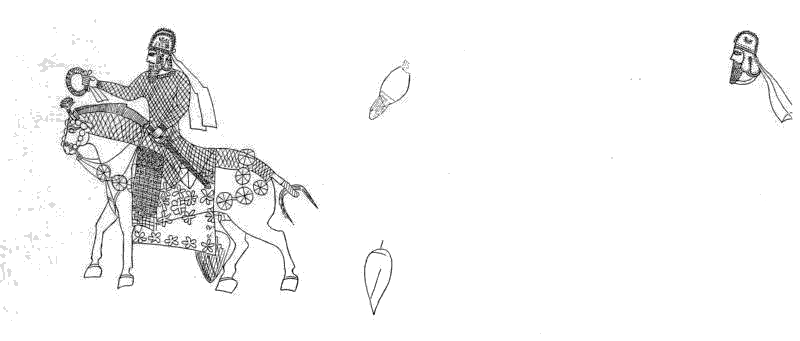 Fig. 3 – Graffito no. 2, left part (after Calmeyer 1976: fig. 3). Not to scale.
Fig. 3 – Graffito no. 2, left part (after Calmeyer 1976: fig. 3). Not to scale.
The horse, of a race with small head and powerful body, has a tuft of tied hair drawn up above the head, while the mane is trimmed regularly, and wears a short caparison along the neck and body; the tail is combed in a plait ending in two bifurcated points. The harness is elaborate: small plain phalerae decorate the muzzle harness, while across the chest and rump the straps carry elaborate circular phalerae; a larger oval ball of hair hangs from below the square saddle blanket, which is decorated with five-petalled flowers.
 Fig. 4 – Graffito no. 2, left part (after Sami 1338: fig. following p. 274). Not to scale.
Fig. 4 – Graffito no. 2, left part (after Sami 1338: fig. following p. 274). Not to scale.
In Calmeyer’s version of the drawing, two oval balls of hair from the horses’ harness are represented at a certain distance behind the mounted figure (elements of figures rendered in painting? see below), whereas even further behind is the head in profile to the left of a male princely figure with beard and curved cap with ear-flaps and neck-shield, decorated with a crescent at the middle, dotted border and what seems to be the indication of the scaled central crest along the outer perimeter, with two long ribbons behind. To the right of the latter, we see a male bearded bust with head in profile to left, with tall curved cap with ear-flap and neck-shield and long ribbons from the nape, and above this bust are the faces in profile to left of two bearded figures. The row of personages is followed on the right by a group of four figures.
The main figure on the right is a male princely personage mounted on a horse, in profile to the left (Figs. 5, 6). The personage wears a tunic, trousers and cloak, each characterized by a different fabric rendered in detail; the cloak, tied on the chest, has two round epaulettes; two short ribbons hang from the dotted shoe. While the bust if frontally viewed, the head is in full profile to the left, with long pointed beard; he wears a tall curved cap with ear-flap and neck-shield, decorated with a crescent at the middle among embroidered (?) dots and with what seems the indication of the scaled central crest along the upper perimetre, with two long ribbons hanging down along the back. With the right hand, visible from across the horse’s neck, he holds the bridles, while his left hand is placed on the hilt of the long sword, whose scabbard is decorated with a row of stars.
Fig. 5 – Graffito no. 2, right part (after Calmeyer 1976: fig. 3). Not to scale.
The horse has a tuft of tied hair drawn up above the head, while the mane is trimmed regularly; the tail is tied at its top with a ribbon. The harness is elaborate: small phalerae decorate the muzzle harness, from which hangs a small oval ball of hair, while across the chest and rump the straps carry elaborate circular phalerae; a larger oval ball of hair hangs from below the square saddle blanket, which is decorated with rosettes and a tasseled border. Ribbons are tied on the four legs, above the heel.
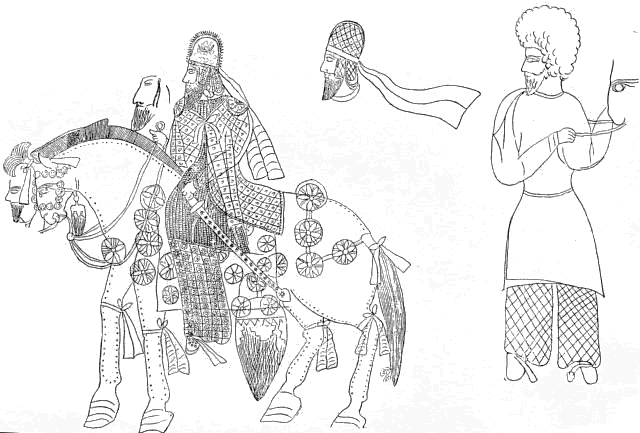 Fig. 6 – Graffito no. 2, right part (after Sami 1338: fig. following p. 274). Not to scale.
Fig. 6 – Graffito no. 2, right part (after Sami 1338: fig. following p. 274). Not to scale.
A second figure is represented in the background, in the space between the princely figure and the neck of the horse: only his head in full profile to the left is visible, characterized by a long pointed beard and a high cap with ear-flaps and neck-shield and pointed top turned backwards (missing in Sami’s version).Two male figures standing almost frontally viewed, with head in profile to the left, wearing plain tunics tightened at the waist and trousers with the indication of their fabric, hold the reins of the horse: both the figures have long pointed beards and flimsy hair with no headdress.
Even though the rendering of the two main figures is somehow stiff and far from naturalistic, the richness and accuracy with which the details are depicted betray the hand of an artist with good drawing capacity. The side figures, instead, are rather summarily executed.
Graffito no. 3 (Allotte de la Fuÿe 1928: fig. on p. 168; Herzfeld 1941: 308, fig. 402; Sami 1338: fig. before p. 275) (Figs. 7-9) – A standing male figure with frontal body, head turned in profile to the right (but in Herzfeld’s drawing the figure is turned to left!) and feet seen from above turned three-quarters to right (?). He wears tunic at knee length, trousers and cloak, each made of different fabric schematically rendered: the tunic has a decorated border at the neck (different indications in the available drawings), the trousers have a long band decorated with chevron pattern along the vertical border of the right leg, while the cloak, tied on the chest, has two round epaulettes. The headdress consists in a plain hemispheric cap with plain neck-shield and long waved ribbon from the nape, surmounted by a seven-pointed fan-like element apparently obtained by tying a large cloth to the head. The figure, with a long beard including moustache, has the left hand (rendered as the right one) placed on the long sword hilt protruding from the waist, whereas the right arm is stretched forward toward a short incense-burner (?), the rendering of which is very different in the available drawings: the elongated ending appearing in Allotte’s version (Fig. 7), is missing in Herzfeld’s (Fig. 8) and Sami’s (Fig. 9) version; in the latter, we have instead the forepart of a caprid running towards the figure, missing in the other two versions.
Fig. 7 – Graffito no. 3 (after Allotte la Fuÿe 1928: fig. on p. 168). Not to scale.
Fig. 8 – Graffito no. 3 (after Herzfeld 1941: fig. 402). Not to scale.
The rendering of the image is rather schematic and simplified, despite the detailed indication of the clothes fabric and of the physiognomic traits.
Fig. 9 – Graffito no. 3 (after Sami 1338: fig. preceding p. 275). Not to scale.
Graffito no. 4 (Schmidt 1953: pl. 199A; Calmeyer 1976: 67, fn. 134, fig. 4; Harper 1981: fig. 19) (Fig. 10, top left) – A male princely figure mounted on a horse, in profile to the left. The personage wears tunic and trousers, each characterized by a different fabric rendered in detail, while the foot has a plain shoe with a ribbon. While the bust if frontally viewed, the head is in full profile to the left, with long rounded-tip beard; he wears a tall curved cap with ear-flaps and neck-shield, decorated with a crescent at the middle and bordered by a dotted perimeter all around, and with what seems to be the indication of the scaled central crest along the upper perimeter, with four long ribbons hanging down along the back. A fan-like element above the head visibly represents a later addition (see below). With the right hand extended before him he holds a ribboned ring-shaped diadem, while his left hand is placed on the hilt of the long sword, whose scabbard is decorated with pearls along the edges.
Fig. 10 – Graffiti nos. 4, 5 (after Calmeyer 1976: fig. 4). Not to scale.
The horse, with a very small head, has a tuft of tied hair drawn up above the head, while the mane is trimmed regularly; the tail is tied by a ribbon at its top. The harness is elaborate: small plain phalerae decorate the muzzle harness, while across the chest and rump the straps carries plain circular phalerae; a larger oval ball of hair hangs from then harness below the horseman.
Even though the scene is less rich in detail as compared to Graffito no. 2, and despite the dis-proportion of the horse’s head, its rendering is less rigid, and betrays the hand of an artist with good drawing capacity.
Graffito no. 5 (Calmeyer 1976: 67, fn. 134, fig. 4) (Fig. 10, bottom right) – A male princely figure mounted on a horse, in profile to the left. The personage wears tunic and trousers, with no indication of the fabric, while the foot appears covered by the trousers. While the bust if frontally viewed, the head is in full profile to the left, with long rounded-tip beard and long hair flowing from the nape of the neck. He wears a tall curved cap with ear-flaps and neck-shield, decorated with a crescent and disk at the middle and with a border all along the perimeter, with two (?) long ribbons hanging down the back. With the right hand extended before him he holds the bridle, while his left hand is placed on the hilt of the long sword.
The horse, with a very small head, has a tuft of tied hair drawn up above the head (?), while the mane is trimmed regularly; the tail is tied by a ribbon at the top. Across the chest and rump the straps carry plain circular phalerae, while a large oval ball of hair hangs from the harness below the horseman.
Despite the dis-proportion of the horse’s head and legs, the rendering of the scene is not rigid, and betrays the hand of an artist with good drawing capacity.but remarkably different from the author of the other graffiti (cf. also Calmeyer 1976: 66, caption to fig. 4).
Graffito no. 6 (Herzfeld 1935: 80 ff., fig. 10; 1941: 308, fig. 401; Sami 1338: fig. after p. 273) (Figs. 11, 12) – A standing male figure with frontal body, head turned in profile to the left and feet seen from above turned three-quarters to right. He wears a tunic at knee length, with decorated border, tightened with a belt at waist, and trousers; the headdress consists in a plain hemispheric cap with two (?) long ribbons from the nape, but the presence of an element of some sort above it is indicated both by a few ondulated strokes in the available drawings and by a specific statement by Herzfeld, according to whom this element was “shaped as on
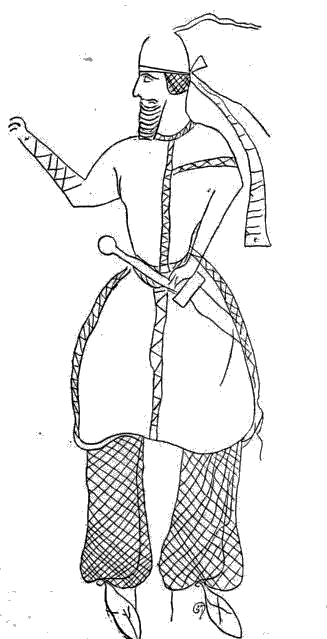 Fig. 11 – Graffito no. 6 (after Herzfeld 1941: fig. 401). Not to scale.
Fig. 11 – Graffito no. 6 (after Herzfeld 1941: fig. 401). Not to scale.
The rendering of the image is extremely schematic and simplified, despite the detailed indication of the trousers’ fabric and the tunic’s border.
Fig. 12 – Graffito no. 6 (after Sami 1338: fig. following p. 273). Not to scale.
As concerns the localization of the graffiti, which as we shall see may have been of some importance for their comprehensive understanding, our information is not uniformly detailed (Fig. 13). Thanks to the accurate recording of E.F. Schmidt, we know precisely that in the Harem of Xerxes, now the Persepolis Museum, Graffito no. 2 is engraved on the S wall of the portico of the Central Section, below the sill of the W window, and Graffito no. 4 is engraved on the S wall of the Main Hall of the Central Section, west of the doorway to the inner court (or, in Calmeyer’s words, ‘rechts neben der westlichen Südtür: see caption to fig. 4). Graffito no. 5 has also the same location as no. 4 (cf. Calmeyer 1976: 66, caption to fig. 4). Two more graffiti are in the some building, even though other authors have not indicated their position in the same detail: Graffito no. 3 is engraved on the S wall of the portico of the Central Section (we do not know the exact point, while this information would be extremely important in order to confirm the hypothesis by Lukonin see below that graffiti nos. 2 and 3 are part of a same investiture scene: see below). Graffito no. 1 is said to be engraved in the Main Hall (Sami 1338: 274; here Graffito no. 6 is also said to be found in the same location: see 275-76).
Fig. 13 – Map showing the localization of the graffiti as can be understood from the bibliography (map after A. Sami, Persepolis, seventh Edition, Shiraz 1970).
In the Tacara of Darius I, Graffito no. 6 is described as being on a side-door of the side apartments (Herzfeld 1935: 80 ff.; 1941: 308; Schmidt 1953: 227, fn. 40).
Since the very first discovery, by comparing them with coins of the ruler of Persis, some of these figures have been identified respectively as “one Manuchihr of Stakhr”, i.e. one of the local dynasts of Fars immediately preceding the Sasanians, as Pabag [Papak], the father of Shabuhr and Ardashir I, and as Shabuhr, the brother of Ardashir I, “who reigned for three months and was killed by a falling stone when visiting Persepolis” (Herzfeld 1941: 308).
Namely, Manuchihr would be one of the figures on the S wall of the Main Hall of Xerxes’ Harem, our no. 4 or 5 (Herzfeld 1935: 81); Pabag would be another figure of the same scene as well as the figure represented in the S wall of the Portico of Xerxes’ Harem, our no. 3 (Allotte de la Füye 1928: 165; Herzfeld 1941: 308, fig. 402; Lukonin 1969: 30, fig. 25.1); Shabuhr would finally be the figure represented on the Tacara, our no. 6 (Herzfeld 1935: 80; 1941: 308, fig. 401) but also the horseman on the left on no. 2. (Lukonin 1969: 30, fig. 25.2)
However, the comparison with the coinage is not so useful in specifically identifying the figures, as has been believed till now on Herzfeld’s footsteps (se also Calmeyer 1976: 65, fn. 131).
Even though the figures bear distinctive marks of their high status, indicated by the diadem which in Arsacid period still represented a kingly prerogative, their identification remains difficult.
The only sure information is that most of the figures have their head in profile to the left, as we see in the coinage of the sub-Arsacid kings of Persis, and that also their headdresses are extremely similar to those of the same dynasty: a high tiara, borded with pearls and with a scaled central crest, with the indication of a specific coat-of-arms at the middle of the side: a crescent or a crescent with disc.
The same type of tiara, in fact, appears on the coins of several kings of Persis, where the main difference between one king and the other is the presence of the crescent alone or of the crescent and dot or of the crescent surrounded by three dots, where the dot can be a representation of a star (see Soudavar 2003: 62).
The first type is found on the coinage of Dare-v/Darayan II, first half of 1st century BC (Alram 1986: 173, pl. 19, no. 564; for the new reading of the name, see Skjærvø 1997: 94). The second type characterizes the images of Napad (Alram 1986: 178, pl. 20, 615), Mantchihr I (Alram 1986: 180, pl. 21, 627), Mantchihr II (Alram 1986: 182, pl. 21, 634), Mantchihr III (Alram 1986: 183, pl. 21, 642), Shabuhr (Alram 1986: 185, pl. 22, 653) and Ardaxshir V (Alram 1986: 186, pl. 22, 656), kings reigning from the second half of the 1st century AD to the first quarter of the 3rd century AD; the third type belongs to the Unknown King II (Alram 1986: 179, pl. 21, 618) and Vadfradad IV (Alram 1986: 180, pl. 21, 623), dated between the end of the 1st and the beginning of the 2nd century AD. The busts attributed to the Unknown King III, second half of the 2nd century AD, have the crescent sometimes with three dots (Alram 1986: 183, pl. 21, 641).
However, the presence of the dot or dots is not so clear neither on the graffiti nor on the coinage, so that we would refrain from relying on this aspect for an identification of the king of Graffito no. 3 with Darayan II.
V.G. Lukonin has also suggested that the tiara, wore by Shabuhr in one of the graffiti (our no. 2, left) is a possible distinctive mark of Shabuhr being a priest of Anahita (Lukonin 1968: 113): but this remark appears contradicted by the other interpretation by the same author, according to which graffiti nos. 2 and 3 are part of a single scene of investiture, in which Shabuhr, dressed as a king (no. 2, left), would receive the investiture from his father Pabag, dressed as a priest (no. 3) (Lukonin 1969: 30).
Apart from the tiaras, other headdresses appear on the graffiti.
One particular case is that of the head of the figure on Graffito no. 4. P.O. Harper interprets the “huge fan-shaped object projecting above the head” of our figure 6, perhaps illustrating “Shapur, son of Papak” (Harper 1981: 53, fn. 71, fig. 19) as part of the headdress, similar to the headdress appearing on a plate from Sari (ibid.: pl. 10) dated between the third and the early fourth century A.D.: a headdress which “is not a royal Sasanian crown type”, but belongs to a “crown prince” (ibid;: 55). However, the remarkable difference between the engraving of all the figure and that of this object, well noticeable in the photograph published by Harper and confirmed by the absence of this detail in the drawing published by Sami, can be explained by the fact that the latter belongs apparently to a second layer of graffiti, intended to render the head similar to that of a Sasanian king.
A second peculiar headdress is the one worn by the standing personage of Graffito no. 3, a seven-pointed fan-like element apparently obtained by tying a large cloth onto the head. This is extremely similar in shape to the five-pointed fan-like element which appears on the head of the figure represented on the reverse of some coin types (Alram 1986: 185, nos. 653-655) of Shabuhr, the predecessor of the last king of Persis and first king of the Sasanians, interpreted subjectively by some scholars as the image of the father Pabag (see below).
Of the other standing figures, the one of Graffito no. 6 has the plain hemispherical cap which, as we have seen, was perhaps surmounted by a further element. If, on the basis of the existing incisions, we can exclude that this element was similar to the fan-like element of Graffito no. 3, we think that the interpretation proposed by Herzfeld as a “huge egg” (v. supra) is only hypothetical. At any rate, even if this should prove correct, the fact cannot be taken as a proof for the identification of the personage as Shabuhr, as Herzfeld does, because the figure wearing this “egg-shaped” headdress – which will then be adopted by Ardashir I in his new role of founder of the Sasanian dynasty (Lukonin 1969: pl. XV, types V-VI) – on one of Shabuhr’s types (Alram 1986: 185, no. 656), is that on the reverse: his identification is doubtful, but in any case different from the king himself (see infra).
Other two in Graffito no. 2 are bare-headed, and have large and full hair. They preceed the mounted figure and keep the reins of his horse, therefore they may represent squires.
An interesting observation is that each of the mounted figures, which seem to enact the main role in the scenes, have a custom slightly differing from the other. Only the figure on Graffito no. 2 wears a cloak over the tunic, of the same shape as the cloak worn by the standing figure of Graffito no. 3. The other three horsemen have only tunic and trousers. Also, the decoration of the fabric in which the costumes have been cut is different from character to character, although it does not appear to be linked to any difference of rank between them: one can only note that the figure of Graffito no. 2 is without doubt the figure which carries the richest decoration, along with the most elaborated horse harness.
The main difference, however, lies in the fact that of the four mounted figures, only two keep, with their extended right arm, the ribboned ring-shaped diadem which in the Sasanian investiture scenes will become the standard symbol of the royal khwarrah. Now, the most richly decorated horseman, the one from Graffito no. 2, is not one of these, and yet seems to have the honour of being led step by step by one or two squires: even more enigmatic is the head with pointed cap turned backwards which appears in the background behind him.
As concerns the horses and their elaborate trappings, the large circular phalerae on the harness straps and the balls of hair hanging from chains occur in Sasanian metalwork and rock reliefs, as well as in Parthian and Palmyrene art (see Harper 1981: 51, and fn. 66 with bibliography).
A striking difference is the one between the tail of the horse of the prince on the left side of Graffito no. 2 and the tails of the other horse figures: whereas the latter are tied with a ribbon at their upper end, near the horse body, as in most of Sasanian reliefs, the tail of that horse is combed in a plait ending in two bifurcated points, such as in the Ardashir I rock reliefs at Firuzabad I celebrating the victory over the Arsacid king, or in the Naqsh-e Rostam reliefs IV and VII: a difference whose significance still eludes us.
As we mentioned before, all the figures are in profile to the left, and the only head in profile to the right could be that of Graffito no. 3, which we have seen similarly on the reverse of the Shabuhr coinage.
If we consider that one of the distinctive changes of the coinage of the Sasanians as compared to the previous Iranian coinages is the change of the profile’s direction, we can perhaps suggests that almost all the figures on the graffiti are not Sasanian princes but rather belong to the kings of Persis.
At the same time, the fact that the only right-facing bust is the one similar to the reverse of the coinage of Shabuhr, might suggest that Graffito no. 3 is the latest in the series. Given that we are not sure about the identity of the personage represented on the reverse of many of the coin types of the kings of Fars, either the father, or the forefather, or even the son or the throne heir (cf. Alram 1986: 164; contra, Lukonin 1969: 29, on the basis of the legend BRH bgy X MLK’, interprets the images on the reverse as those of the father of the king), we cannot use the similarity between Graffito no. 3 and the bust on the reverse of the Shabuhr coinage to prove that the figure on Graffito no. 3 is Pabag: particularly if we keep present that the image represented on the reverse of one of the earliest coin types of Ardashir I, and bearing the same legend as the one of the coins of Shabuhr, wears the typical tiara of the ruler of Persis (Alram 1986: 186, no. 657). We therefore prefer to abstain from a precise identification of the figure, but rather point to its being near in time to the Sasanian period, both for the right-facing profile and the similarity in headdress with the figure on the reverse of the last but one king of Persis.
If, as we have seen, it is more than likely that the figurative characters on the graffiti belong to the sub-Arsacid dynasty of the Kings of Fars, we naturally must ask ourselves what could have been the the purpose of these graffiti, inscribed and perhaps painted on the walls of important edifices of the Achaemenid epoch.
Regarding this, an epigraphic testimony, even if it dates back one to two centuries from the graffiti, seems to be particularly pertinent, providing a key to the reading. These are the two Middle Persian inscriptions, dated to the fourth century A.D., engraved at Persepolis, (Henning 1963: pls. 85 and 87; Frye 1966, with bibliography; Lukonin 1969: 128-29; Azarnoush 1986: 223, 228). Both of them were ordered by a Shabuhr Sakanshah who calls himself a son of Hormozd King of King, and has been differently identified with a son of Hormozd I or a son of Hormozd II and brother of Shabuhr II. Leaving aside the problem of the true identity of the personage, what is interesting for us is what is recorded in one of the two inscriptions, the longest one, engraved on a door-jamb to the S of the main hall of the Tacara: V.G. Lukonin translate it as thus: “He [i.e. Shabuhr Sakanshah] arrived in Persepolis [st stwny, “hundred columns”], and had wine near this building. He made great rejoicing and ordered to perform service for the Gods [yzd’n]. He proclaimed praise to his father and grandfather. He proclaimed praise to Shabuhr, King of Kings. And proclaimed praise to himself. He lauded those who built this palace” (Lukonin 1969: 129).
It is not by chance that just in Persepolis Shabuhr Sakanshah had a banquet, ordered rites for Gods, and gave blessing to his father and grandfather. In the long debate about the continuity between the Achaemenid and the Sasanian dynasts, it is now every day clearer that the Sasanians considered themselves heirs of the Achaemenians, whom they knew in a distorted way (cf. Roaf 1998) nevertheless correctly as the authors of Persepolis imposing buildings. This process is not new to the Sasanian dynasty, since it is probably already present in the Fratarakas of Hellenistic Fars: in the coinage of their first series, in fact, the link with the Achaemenid dynasty is stressed both by the legend and particularly by the iconographic elements of the standard and of the building appearing on the reverse (Chaumont 1959: 179; Callieri 1998: 36; for a different interpretation, see Panaino 2003; on this question, see also Skjærvø 1997: 102).
As R.N. Frye has recalled in a paper on the rise of the Sasanians, even during the time of the Fratarakas “the ruins of Persepolis were present, however, to remind the people of the power and magnificence of their ancestors” (Frye 1975: 238).
There seems to be a continuity from the Fratarakas to the early Sasanians in the privileged relationships with these ruins, lasting at least to the fourth century, when Shabuhr Sakanshah had his inscriptions engraved there (cf. also Wiesehöfer 1994: 139, fn. 4).
The act of incising (and painting) on the walls of these ancient monuments would therefore represent an homage to the ancestors, and at the same time a mark of ownership of the ruins and a way to point out the continuity between those kings of the mythical past and the kings of the present time.
This connection with the Sasanian period leads us to examine one last important aspect of the graffiti, which the remarkable iconographic similarities with some of the themes of the Sasanian rock reliefs immediately recall: the role that they have carried out in the development of Sasanian Art.
E. Herzfeld, with his usual insight, comparing the Persepolis graffiti with the graffiti from Dura Europos, underlines their importance to show that “even before the Sasanian period the repertory of motifs that were typical of Sasanian sculpture existed in painting”: “we may assert that a traditional painting was from the beginning the constituent factor also of Sasanian rock-sculpture” (Herzfeld 1941: 308). At the same time, the graffiti “reveal the artistic conception behind the conventionalized forms of the large rock-sculptures” (ibid.): the graffiti would in this way be really the starting point of Sasanian rock-sculpture.
Herzfeld’s view is fully shared by K. Erdmann, who recalls them among the art production which has influenced the birth of Sasanian art (Erdmann 1969: 55-56). The opinion of the two scholars can still be considered still valid, given the deep similarity between the graffiti and the Sasanian rock reliefs.
However, Herzfeld’s observations on the connection of these graffiti with painting seems particularly fitting also. When visiting the site of Persepolis some years ago, the present author was impressed by the fact that the signs incised on the stone are so thin, that the motifs are barely visible, only with a grazing light. Therefore, it is likely that the graffiti were originally painted with colour, and that the incisions were only the preliminary phase of the painting.
Indeed, if we examine the whole of Graffito no. 2, we can really consider the possibility that the minor figures, or better the figures of which only parts are represented in the different modern drawings, are not parts of an unfinished scene (Calmeyer 1976: 65), but may represent engraved patches of a larger scene which were originally painted. If we try to complete all the engraved figures with painted ones, now vanished, we have the representation of a procession, in which mounted princely figures line up with their horses each guided by two standing figures (rather than an investiture on horse with the omission of the god as suggested by Abka’i-Khavari 2000: 37).
This hypothesis will be verified when it is hopefully possible to examine the graffito with infra-red techniques in order to detect the original presence of colour.
However, coming back to Herzfeld’s observations, there is a remarkable difference with the graffiti from Dura-Europos, now available in a comprehensive publication (Goldman 1999). Whereas Dura graffiti are real “occasional” graffiti, incised by common persons not always having a professional training in drawing, Persepolis graffiti show to be the work of well-trained craftsmen. Herzfeld himself recognizes that “the picture of Papak is a work of amazing technical skill” (Herzfeld 1941: 308). Therefore, they are not extemporary traces but works of art, commissioned by the personages which are represented.
Pictorial graffiti are quite rare in Iran. The only area where this form of art has been extensively recorded is that of Birjand, in Southern Khorasan. Here in the 1950s a Persian student identified on the rock-walls of the gorge known as Kal-e Jangal several rock drawings, i.e. drawing in which the line was obtained by simply skratching the surface of the stone without incision, and therefore different from graffiti: “a rock drawing of a man and a lion”, accompanied by a Parthian inscription, “a rock drawing of a male bust (bearded head, with helmet and diadem, in profile turned to the left), with a damaged Parthian inscription,” as well as fragments of seven other inscriptions, all apparently in Parthian, belonging to different periods (Henning 1953: 132-33). On the basis of the reading of the inscription, mentioning the name of a city named after Ardashir (the Sasanian king), Henning is inclined to date the first image also to the early Sasanian period, whereas as regards the male bust (the photo of which, published in an Iranian volume, is not available to the present author), he stresses the fact that it is “reminiscent of the representations of the Parthian kings on their coins”, and therefore “somewhat older” (Henning 1953: 135). Indeed, the motif of the foot combat with the lion is represented once on Sasanian rock reliefs (Barham II at Sar Mashhad) whereas on Sasanian silver vessels the combat with the lion is generally on horse; the rendering of the trousers and foot is not dissimilar to that on several mounted king images on Sasanian vessels (e.g. Harper 1981: pls. 9, 10).
However, in recent times the area of Birjand has been the object of a thorough campaign of surveying rock drawings, graffiti and inscriptions, which has located a new and rich rock-wall at the site of Lâkh Mazâr, near the village of Kutch (Labbâf Khâniki & Bashâsh 1994). Apart from the inscriptions, several human heads, all in profile (ibid.: figs. 13-14), as well as images of lions and caprids (ibid.: figs. 15-16) have been recorded, plus a large number of very poor graffiti which are likely to belong to recent times. Particularly noteworthy as regards the high craft level is the image of a lion with an extremely elaborate rendering of mane and paws (ibid.: fig. 15, D2). While the epigraphical study has suggested a date to the Sasanian period, and particularly to the reign of Kawad, a similarity of some of the busts with Hephthalite busts on engraved gems and coins confirms, at least for a part of the images, a date to the 5th century AD, whereas for some images of lion, a date in the Parthian period has been proposed on rather weak grounds (ibid.: 29-30). It is therefore likely that the rock-wall was sited in such a position that it was used for graffiti for some time during the Sasanian period, while the existence of pre-Sasanian material is still to be proven.
The testimony of Birjand, therefore, although of great interest as far as concerns the common choice to use graffiti as the technical means, is, as comparative material, of secondary importance due to its placement in time which surely comes after that of Persepolis.
References
Abka’i-Khavari, M. (2000) Das Bild des Königs in der Sasanidenzeit (Texte und Studien zur Orientalistik, 13). Hildesheim-Zürich-New York.
Allotte de la Füye (1928) Graffitis relevés en 1928 dans les ruines de Persépolis. Revue d’assyriologie et d’archéologie orientale 25, pp. 159-168.
Alram, M. (1986) Nomina propria iranica in nummis. Materialgrundlagen zu den iranischen Personennamen auf antiken Münzen (Iranisches Personennamenbuch, IV). Wien.
Azarnoush, M. (1986) Shapûr II, Ardashir II and Shâpûr III: Another Perspective. Archäologische Mitteilungen aus Iran, n.F., 19, pp. 219-47.
Callieri, P. (1998) A proposito di un’iconografia monetale dei dinasti del Fars post-achemenide. OCNUS, 6, pp. 25-38.
Calmeyer, P. (1976) Zur Genese altiranischer Motive V. Synarchie. AMI, N.F. 9, 1976, pp. 63-95.
Chaumont, M.-L. (1959) Papak, roi de Staxr, et sa cour. Journal Asiatique, 247, pp. 175-91.
Curtis, J. & Finkel, I. (1999) Game Boards and Other Incised Graffiti at Persepolis. Iran, XXXVII, pp. 45-48.
Erdmann, K. (1969) Die Kunst Irans zur Zeit der Sasaniden. Repr. Mainz (1st ed. Berlin 1943).
Faccenna, D. (1997) Sculptors’ trial pieces in Gandharan art. East and West, 47, pp. 67-93.
Frye, R.N. (1962) The Heritage of Persia. London.
Frye, R.N. (1966) The Persepolis Middle Persian Inscriptions from the Time of Shapur II. Acta Orientalia 30, pp. 83-93.
Frye, R.N. (1975) The rise of the Sasanians and the Uppsala school. Monumentum H.S. Nyberg, I (Acta Iranica 4, deuxième série, I), Leiden- Téhéran-Liège, 1975, pp. 237-45.
Goldman, B. (1999) Pictorial Graffiti of Dura-Europos. Parthica-Incontri di culture nel mondo antico, I, pp. 19-106.
Harper, P.O. (1981) Silver Vessels of the Sasanian Period. I. Royal Imagery. New York.
Henning, W.B. (1953) A New Parthian Inscription. Journal of the Royal Asiatic Society, pp. 132-36.
Henning, W.B., ed. (1963) Minor Inscriptions of Kartir (Corpus Inscriptionum Iranicarum, 3). London.
Herzfeld, E. (1935) Archaeological History of Iran. London. Herzfeld, E. (1941) Iran in the Ancient East. New York.
Hinz, W. (1966) Die Felsreliefs Ardashirs I. In Altiranische Funde und Forschungen, 115-44. Berlin.
Labbâf Khâniki, R. & Bashâsh, R. (1994) Sang-negâre-ye Lâkh Mazâr, Birjand (Selsele-ye maqâlât-e pojuheshi, 1). Tehran 1373.
Loukonin, V.G. (1968) Monnaie d’Ardachir I et l’art officiel sassanide. Iranica Antiqua, 8, pp. 106-17.
Lukonin, V.G. (1969) Kul’tura sasanidskogo Irana. Iran v III-V vv. Otcherki po istorii kul’tury. Moskva.
Roaf, M. (1998) Persepolitan Echoes in Sasanian Architecture: Did the Sasanians attempt to re-create the Achaemenid empire? The Art and Archaeology of Ancient Persia. New Light on the Parthian and Sasanian Empires, ed. V. Sarkhosh Curtis, R. Hillenbrand, J.M. Rogers, pp. 1-7. London-New York.
Sami, A. (1338) Naqqâshi va tarâhi az ru-ye noqqushriz-e Sâsâni. Gozâreshhâ-ye bâstânshenâsi. 4. Moshtamel bar haffâri va xâkbardâri va ta‘mirât-e Pâsârgâd va Taxt-e Jamshid az sâl-e 1331 tâ sâl-e 1338 xurshidi, pp. 270-76. Shirâz.
Schmidt, E.F. (1953) Persepolis. I. Structures, Reliefs, Inscriptions (Oriental Institute Publications, LXVIII). Chicago.
Skjærvø, P.O. (1997) The Joy of the Cup: A Pre-Sasanian Middle Persian Inscription on a Silver Bowl. Bulletin of the Asia Institute, 11, pp. 93-104.
Soudavar, A. (2003) The Aura of Kings. Legitimacy and Divine Sanction in Iranian Kingship. Costa Mesa, Ca.
Wiesehöfer, J. (1994) Die “dunklen Jahrhunderte” der Persis. Untersuchungen zu Geschichte und Kultur von Fârs in frühhellenistischer Zeit (330-140 v. Chr.) (Zetemata, 90). München.

